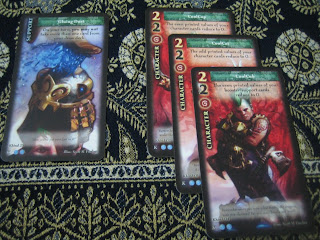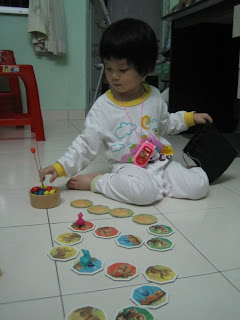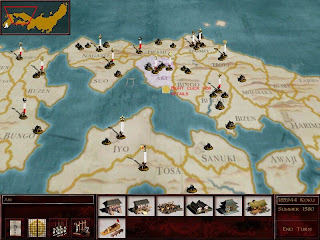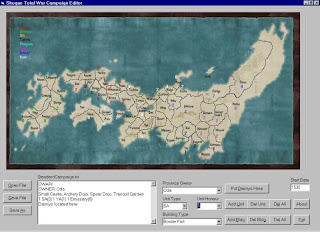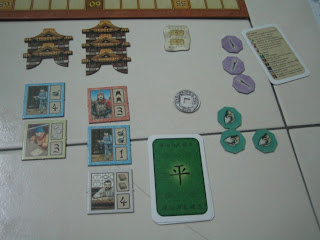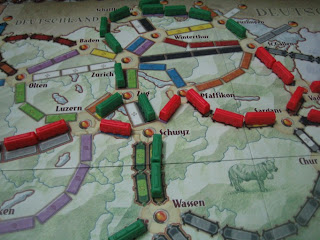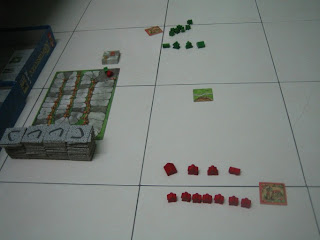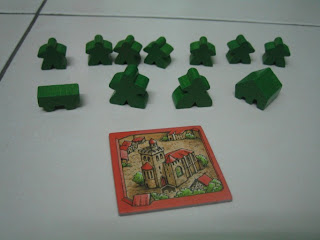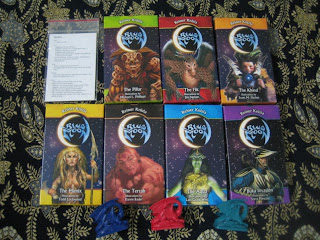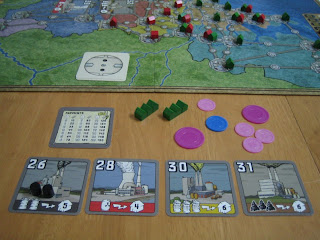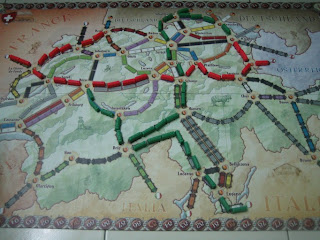Sat 5 Jan 2008 was Han and my first gaming session of 2008. I invited an old friend Alvin, who is new to our kind of modern boardgames. That's a good start to the year. Hopefully we will finally be able to "recruit" more members to our gaming sessions.
Ivanhoe is a quick card game, which Han, Michelle and I played (Alvin was very late). It is a new game to me. It is themed around knights and tournaments, but the theme is pretty thin. The cards are just five different coloured suits with different numbers, some white jokers, and some special action cards. The objective of the game is to be the first to win all five types of tournaments, from melee, swordfighting to morning star, jousting. In other words, to win fights in all five colours. The player who starts a fight decides the type of tournament (i.e. which colour) and plays a card (or more) of that colour. Subsequent players who want to stay in the fight must play cards of the same colour to exceed the previous player's total number. There are jokers, and there are special action cards. The tournament goes on until all but one player is left standing. The winner then claims a coloured coin (the trophy?) to indicate he/she has won this type of tournament.
One interesting thing is the maiden (one of two types of jokers). Maidens have a high value of 6, and help you greatly to win a fight. However, if you play a maiden card (i.e. you become her champion) but lose the fight, you have to surrender one of your previously won trophies (coins). That's the price you pay for disappointing the lady.

My hand of cards in Ivanhoe. There are coloured cards, white cards (jokers) and special action cards. And here I have the Ivanhoe card, which can cancel the effects of any other special action cards.

The draw deck and the discard deck.

This was a high risk fight between Michelle and Han, as both of them have committed a maiden (white 6). The loser in this battle would have to surrender an already won trophy.
This is a very simple and quick card game. I did quite badly from the start, losing some hard fights, and falling behind 4, 4, 1. Since you start the game with one random coin, that means I had zero victories when both Han and Michelle already had three each. However, a surprising thing happened and I bounced back from last place to win the game. I had a lot of weak green cards which I could not use for other coloured fights. Green cards (melee) are always 1, and I had a lot of them. This won me the melee. Then in a few other tournaments, I think Han and Michelle were running out of the appropriate coloured cards, and I won those without having to play many cards. So, I guess one should never give up hope.
Conquest of the Fallen Lands uses hexagonal tiles like Settlers of Catan. The board made up of these tiles represent the land which has been taken by evil forces. The players are the good guys, and compete to conquer these lands back.
You start the game with some money, two servants, and some cards. There are three types of servants - soldiers, mages (wizards) and carpenters. You need them to play your cards. Each servant can only be used once per turn, i.e. if you play a troop card which requires two soldiers and one carpenter, then these three servants will be "used" this turn. Every turn you can pay $5 to recruit a new servant to increase your workforce. They are basically slaves because you don't need to pay them any salary afterwards (or they just like you so much to not mind that).
The cards are mostly troop cards, which have an attack and a support value. You can only play one troop card onto one hex to conquer it. The attack value of that card, plus the support values of other cards (belonging to you) already on the board and next to that hex, must equal or exceed the number of your target hex. There are some support cards, which can only be added to a hex after it has been conquered, and you also can only place one per hex. They work in a similar way as the support value of the troop cards. There are also some magic cards which let you do special things.

Close-up of Conquest of the Fallen Lands. The glass beads indicate ownership. Hexes without cards yet are not yet conquered. You can see how far behind I am (I am green).

Han: "My cards suck big time." (but he still beat me soundly)

My cards - two magic cards and lots of troop cards.

More than half the lands are conquered at this point.

My servants and my money.
Because of how hexes on the board are claimed, and how your troop cards placed on the board are usually needed to support your future conquests, the game is quite spatial. You need to plan where to start your conquest and then use it as a base to expand further. You are not required to conquer only adjacent hexes after you have conquered your first hex, but it does help a lot because of the support value of your cards already on the board. So in this game you need to watch out not to be cut off by your opponents, and you need to plan for your expansion. You can't attack your opponents, because, hey, you are all supposed to be the good guys fighting the evil forces together. But you can attack those hexes which they are planning to attack, stunting their expansion and depriving them of loot. Yes, every time you conquer a hex, you earn money based on the number on the hex. And the richest player at game end (when all hexes are conquered) wins. In the game you can spend money to recruit more servants, so every time you do so you are basically surrendering victory points. So, there is a balancing act in terms of how many servants you recruit (more servants will allow you to make more attacks, build more support buildings, use more magic), and also in terms of when to start saving money. From my first playing, this balancing doesn't seem to be too big a factor. The spatial element was more important. It was a race to be as efficient as possible in conquering the hexes, and in grabbing as many as possible before your oppoent does.
This is an interesting game and one I don't mind playing again. Hopefully I can do better next time with the spatial element, on which I did poorly this time.
Thebes is a game about archeology in the early 20th century. Players are archeologists traveling around Europe and the Middle East, studying history, digging up artifacts, putting up exhibitions of these artifacts, and attending conferences; and these four activities basically sum up the ways you score points in this game.
The element in this game which is most talked about is how time and turn order is managed. There is a track around the board showing 52 weeks of a year. Each action you take takes time, e.g. traveling for 2 weeks from London to Rome, and then spending 1 week there gaining 1 special knowledge about Egypt. After taking this action, you move your marker 3 weeks forward, indicating you have spent 3 weeks in total on your turn. The game is played over 2 to 3 years, depending on the number of players. There is no turn order. Whoever is last on the time track is the next player. Sometimes if you do an action that takes a long time, you may need to wait a long time for your turn. Sometimes if you take an action that takes a short time, you can still be last on the time track, and you can take another turn.
This game is beautifully produced, and is fun to play. It is quite immersive, as your little archeologist travel around the map picking up knowledge, excavating artifacts, attending conferences. There is a significant luck element, in the excavations. When you dig, you pull a number of tiles out of a bag. The number of tiles depends on how much knowledge you have on that location (e.g. Crete, Mesopotamia), and how many weeks you are willing to spend digging. At the start of the game, about half the tiles are sand, i.e. you gain no artifact. After any player excavates, he/she keeps the artifacts found, but returns the sand into the bag. So, the later you excavate at a site, the worse your chances become. Sometimes when you have poor luck, you draw no artifacts, or you draw low valued artifacts. So, be prepared for this and don't complain about luck.

Michelle, Alvin and Han studying for their history exam tomorrow. By playing Thebes.

The beautiful map of Thebes. There are always four items available for you to collect (lower right of this picture), and there can be up to three exhibition invitations that you can claim (upper left of this picture).

My specific knowledge (coloured books), general knowledge (open books), congresses attended, assistants recruited. On the right is a cool device used to determine how many chips you draw from the bag when you do an excavation. It depends on how much knowledge you have and how many weeks you are prepared to dig. This is way more cool than a boring table / chart.
I find this game to be quite fun to play, and quite suitable for families. Although not as simple as games like Ticket To Ride, the rules are not difficult, and are very intuitive. I especially enjoy the lucky draw factor of excavating - same reason as why I like Africa. There are meaningful decisions to be made, and planning to be done, and competition in different areas. However, one should take this as a light and fun game and play in a relaxed manner. Don't start complaining about how your planning and perfect moves were ruined by bad luck. Just have a laugh.
This was the only game that Alvin managed to play with us. He only reached my home at about 3:30pm. We had started at 2pm. He enjoyed himself and appeared quite amazed by this new type of boardgames. He said there was a time when he played a lot of Ludo with is wife because they had nothing better to do. Hopefully Alvin will join us again in future and maybe even become a regular or semi-regular player.









